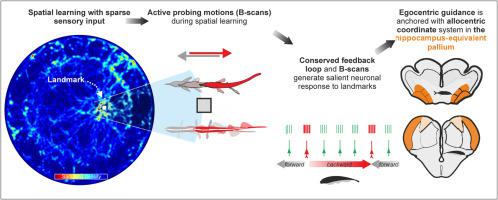Current Opinion in Neurobiology ( IF 5.7 ) Pub Date : 2021-08-12 , DOI: 10.1016/j.conb.2021.07.002 Jacob Engelmann 1 , Avner Wallach 2 , Leonard Maler 3

|
Weakly electric fish can learn the spatial layout of their environment using only their short-range electric sense. During spatial learning, active sensing motions are used to memorize landmark locations so that they can serve as anchors for idiothetic-based navigation. A hindbrain feedback circuit selectively amplifies the electrosensory input arising from these motions. The ascending electrolocation pathway preferentially transmits this information to the pallial regions involved in spatial learning and navigation. Similarities in both behavioral patterns and hindbrain circuitry of gymnotiform and mormyrid fish, two families that independently evolved their electrosense, suggest that amplification and transmission of active sensing motion inputs are fundamental mechanisms for spatial memory acquisition.
中文翻译:

将弱电鱼的主动感知和空间学习联系起来
弱电鱼可以仅使用短程电感来了解其环境的空间布局。在空间学习过程中,主动感知运动用于记忆地标位置,以便它们可以作为基于特质的导航的锚。后脑反馈电路选择性地放大由这些运动产生的电感应输入。上行电定位通路优先将此信息传输到参与空间学习和导航的大脑皮层区域。裸眼鱼和鳐鱼的行为模式和后脑回路的相似性,这两个家族独立进化了它们的电感应,这表明主动感应运动输入的放大和传输是空间记忆获取的基本机制。



























 京公网安备 11010802027423号
京公网安备 11010802027423号